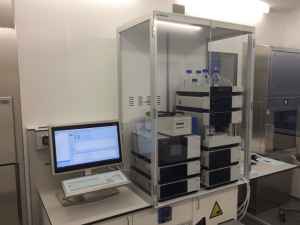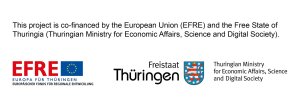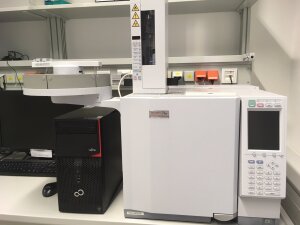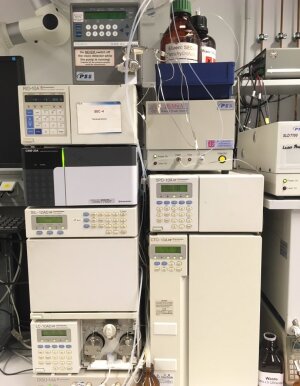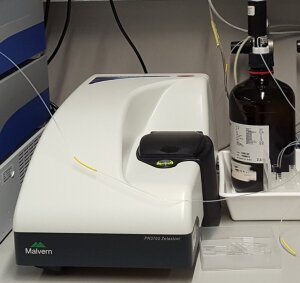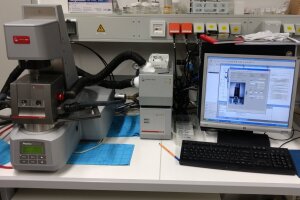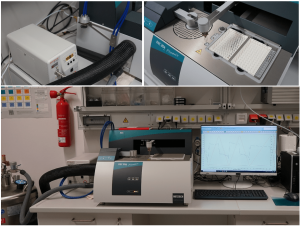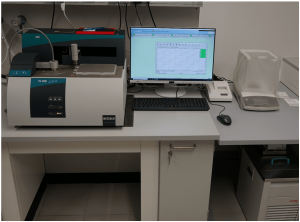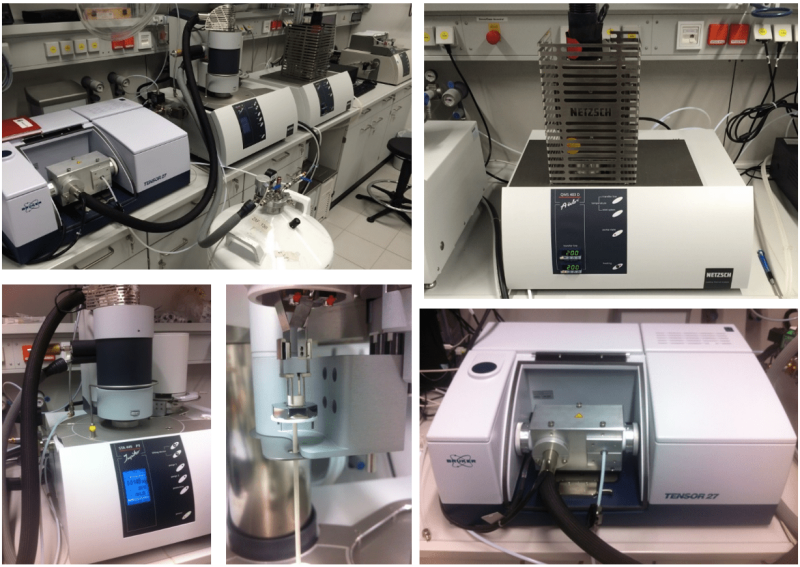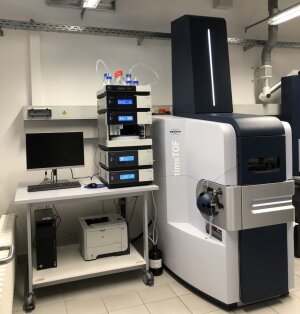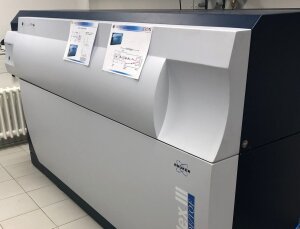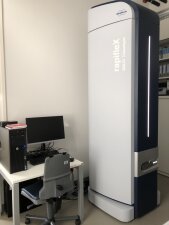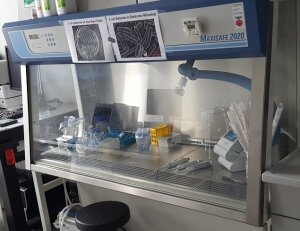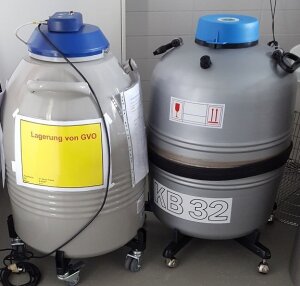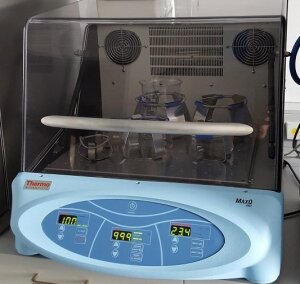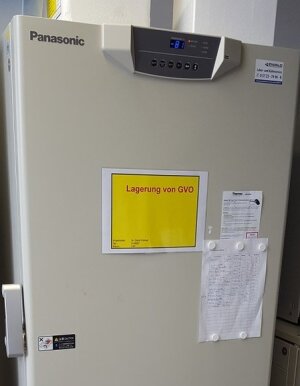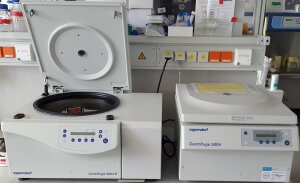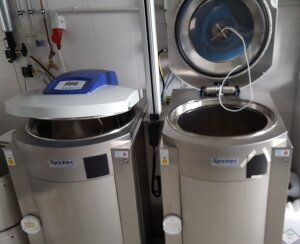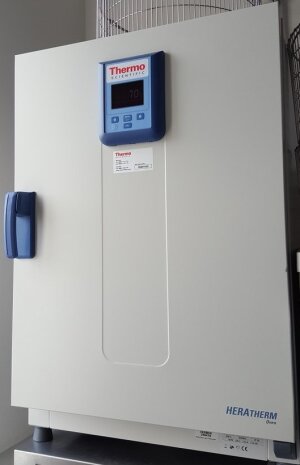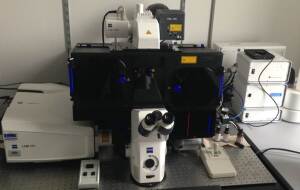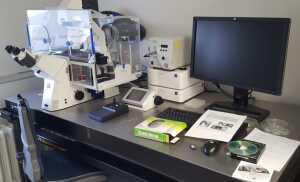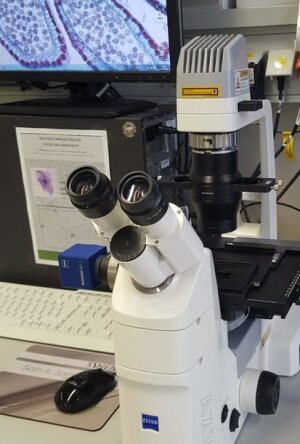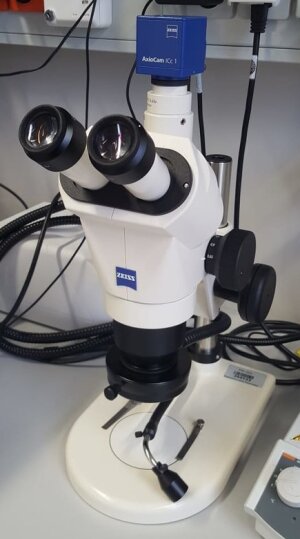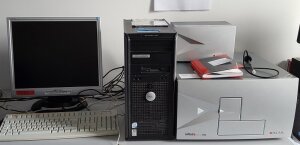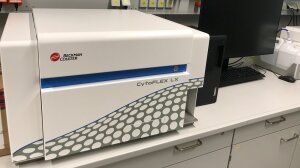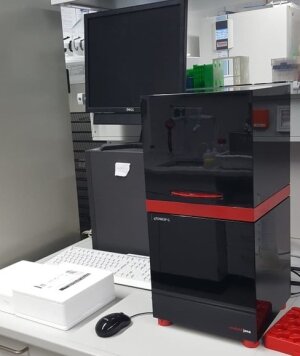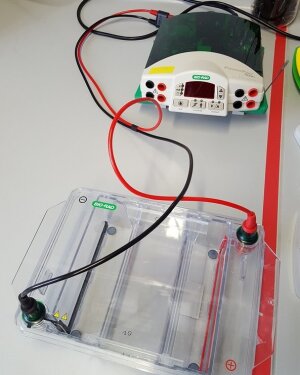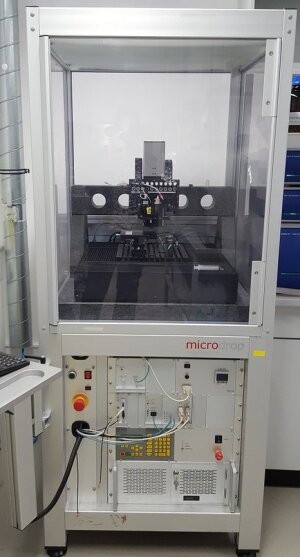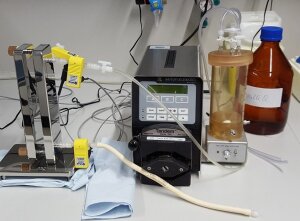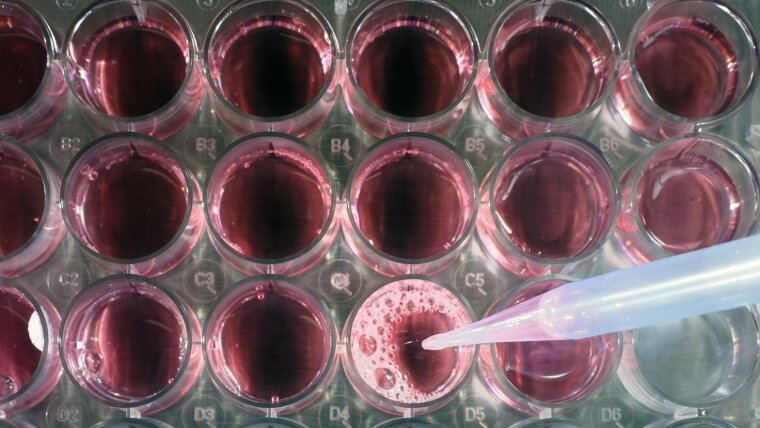
The laboratories of the Schubert group are equiped with the most advanced robotic platforms to perform automated synthesis and high throughput experimentation.
This in combination with high speed analysis equipment with over 10 LC systems equipped with autosamplers and high throughput extensions, Analytical Ultracentrifuges, automated parallel viscosity meter, GC and GS-MS, various UV/vis and IR spectrometers equipped with platereaders, RAMAN spectrometer, DLS, Elemental Analysis, MALDI-TOF-TOF and ESI-TOF-MS leads to a nearly perfect work flow. With the power of Batch-, stopped-flow- and continuous feed microwave assisted synthesis (with equipment from Biotage, CEM, Anton Paar and Milestone), inkjet printing, thermal analysis (DSC and various TGA equipment) and surface analysis such as Nanoindentation, Contact Angle measurement, Confocal Microscopy, AFM, TEM and SEM, the laboratories are to be considered state of the art.
Analytical Instruments
UltiMate 3000 Dionex UHPLC
Image: Antje VollrathUltra-high-performance liquid chromatography (UHPLC)
For the production of high-quality nanoscale drug delivery systems, formulation and characterization in a controlled cleanroom environment using the principles of Good Manufacturing Practice are essential. For this purpose, both the polymeric starting materials used for the formulation of the nanoobjects and the active ingredients to be encapsulated, as well as the final produced nanocontainers, must be thoroughly characterized. The key technology for these investigations is a flexibly applicable ultra-high-pressure liquid chromatography (UHPLC), with which various analytes can be accurately checked before and after the manufacturing process.
The system includes an automatically controllable column oven with a variety of applicable columns and eluents (quaternary pump) for optimal separation results. In addition, a wide portfolio of selective detection options (absorption, fluorescence) and universal detection options (refractive index, charged aerosol detector) is available, which can be used simultaneously. The modern system allows not only the quantitative detection of relatively small molecules (active ingredients, excipients, possible impurities, and degradation products) but also the comprehensive analysis of high-molecular-weight polymers. Furthermore, it is equipped with a fraction collector.
System Parameters
- Pump allows the use of up to 4 solvents
- Autosampler with temperature control
- 2 column ovens (up to 6 columns)
- 4 detectors (DAD, FLD, CAD, RID)
- Cleanroom PC with Chromeleon software
- Fraction collector
Gas Chromatography - Mass Spectrometry
Furthermore, our labs are equipped with two Shimadzu GC-MS systems (GC-2010/GCMS-QP2010) both comprised of a general-purpose column with a low-polarity phase (diphenyl dimethylpolysiloxane) and a quadrupole detector.
laboratory equipment
Size Exclusion Chromatography
To characterize our macromolecules regarding their molar mass distributions, several SECs are running with various solvents both organic (chloroform, THF, dimethyl acetamide) and aqueous. The different SEC systems (Agilent/PSS, Jasco, Shimadzu) are equipped with RI and UV detectors for routine analysis as well as a viscometer and a multi angle light scattering detector to determine intrinsic viscosities and absolute molar masses, respectively. Additionally, one SEC is equipped with a semi-preparative column for polymer purification.
Laborgerät
Asymmetrical Flow Field-Flow Fractionation
Asymmetrical Flow Field-Flow Fractionation (AF4) allows for the separation and characterization of proteins, polymers, and nanoparticles in a time-efficient and gentle way. The separation is based on differences in the diffusion coefficient among sample components, while their size and molar mass is detected by laser light scattering.
Analytische Ultrazentrifugation
Analytical Ultracentrifugation
Analytical Ultracentrifugation utilizes the density difference between colloid and solvent for their separation according to size, shape, and density in almost any solvent of choice. It is the most eminent method in colloidal characterization science and allows assessment of absolute molar masses, heterogeneity in samples, as well as degree of aggregation of colloidal objects. It is very powerful as well to characterize nanoparticulate materials.
Dynamische Lichtstreuung
Dynamic Light Scattering Measurement
Dynamic light scattering makes use of the Brownian motion of colloidal objects in solution in order to derive their diffusion coefficient, consequently their estimated hydrodynamic diameter. The plate reader allows for many samples being run in an efficient fashion without manual interference.
Laborgerät
Automated Parallel Capillary Viscometry
The Lauda viscosity measuring system PVS 1/4 is an automated parallel system in which up to four capillaries can be used. The measuring stand S5 can work with Ubbelohde, Cannon-Fenske or Ostwald capillaries, covering a viscosity range from 0.3 up to 50.000 mPas. The autosampler provides a high sample throughput up to 63 samples, depending on reservoir size, which can be processed in one setting. Also hot polymer solutions or oils can be handled in the heated rack with heated dosing syringe. In addition, the cleaning module VRM provides fully automatic cleaning and drying of the viscometers. The attached dosimat allows the determination of the limiting viscosity through different concentration steps, in conjunction with a dilution viscometer, thus allowing the determination of the molar mass by using, e.g., the Mark-Houwink-Sakurada equation.
Rheologie
Rheology
The Anton Paar Physica MCR 301 is based on a modular design which features special innovations such as an automatic measuring and accessory detection system, and a measuring gap detection system, as some examples. In addition, it provides a wide selection of measurement geometries (plate-plate, cone-plate, double-gap, etc.), interchangeable environmental systems (e.g. magnetorheological device and convection oven) and special accessories (e.g. solid bar fixture system). The high-resolution optical encoder enables precise measurements of the angular deflection, and together with the real time position control in oscillation, it is possible to control very small oscillatory strains. In addition, the air bearing synchronous motor shows a very low drift and low torque capabilities. With the convection temperature device CTD 450, a wide temperature range from -100 °C up to 450 °C can be covered together with different measuring systems.
Netzsch 204 F1 Phoenix Photo DSC
Image: Renzo M. PaulusPhoto DSC
The Netzsch 204 F1 Phoenix is a Photo Differential Scanning Calorimeter (DSC). This is a scientific instrument used to study the thermal properties of materials. It measures the heat flow associated with physical and chemical changes occurring in a sample as it is subjected to controlled temperature variations.
The DSC works by comparing the heat flow of a sample to that of a reference material while both are subjected to the same temperature program. When the sample undergoes phase transitions (such as melting, crystallization, or chemical reactions), it absorbs or releases heat, which is detected and recorded by the DSC. The resulting data provides valuable insights into the material's melting points, phase transitions, enthalpy changes, purity, and other thermal properties.
By combining UV-light exposure with thermal analysis, Photo DSC can provide insights into light-induced effects, such as photochemical reactions and photothermal events, which are not observable with standard DSC. This technique is particularly useful in studying photoactive materials, light-sensitive chemicals, and various photophysical processes. It helps researchers understand how a material responds to both thermal and light stimuli, contributing to a deeper understanding of its properties and behavior.
Netzsch 209 F1 Iris TGA
Image: Renzo M. PaulusTGA
The Netzsch 209 F1 Iris Thermogravimetric Analysis (TGA). This is a technique used to study the thermal stability and composition of materials. It measures the weight changes of a sample as it is subjected to controlled temperature variations in an inert or reactive atmosphere.
During a TGA experiment, the sample is placed in a temperature-controlled furnace, and its weight is continuously monitored as the temperature is ramped up or down. As the temperature increases, the sample may undergo various processes such as decomposition, volatilization, oxidation, or other chemical reactions. These processes cause weight loss or gain, which is recorded by the TGA instrument.
By analyzing the weight changes and temperature data, researchers can gain insights into several properties of the material, such as its thermal stability, decomposition kinetics, moisture content, and purity.
STA-MS-FTIR
Simultaneous Thermal Analysis (STA) is a powerful analytical technique used in materials science and chemistry to investigate the physical and chemical properties of a substance as it undergoes controlled changes in temperature. STA combines two complementary methods: Differential Scanning Calorimetry (DSC) and Thermogravimetric Analysis (TGA) in a single experimental setup.
When coupled with Mass Spectrometry (MS) and Fourier Transform Infrared Spectroscopy (FTIR), Simultaneous Thermal Analysis (STA) becomes an even more powerful and versatile analytical technique, often referred to as TG-DSC-MS and TG-DSC-FTIR, respectively. These additional analytical tools further enhance the capabilities of STA by providing valuable information about the chemical composition and molecular structure of the substances undergoing thermal changes. By combining TG-DSC with both MS and FTIR, researchers can obtain a comprehensive understanding of the thermal behavior, decomposition mechanisms, and chemical reactions taking place in a material. This multi-dimensional approach enables detailed insights into the molecular composition, functional groups, and reaction kinetics, making it an indispensable tool for advanced materials characterization, environmental studies, and chemical analysis in various research and industrial applications.
Netzsch 449 F3 Jupiter
Image: Renzo M. Pauluslaboratory equipment
ESI/APCI-TOF mass spectrometer
The micrOTOF QII is a Time-of-Flight (TOF) mass spectrometer. The instrument is equipped with either an Electrospray Ionization (ESI) source for the analysis of polar analytes or an Atmospheric Pressure Chemical Ionization (APCI) source for the analysis of nonpolar substances. Additionally, the instrument can be coupled to an HPLC system (Agilent 1200 series with diode array detector) to separate sample components prior to mass spectrometry.
Laborgerät
Image: FSU Jena/Nicole FritzIon Mobility Mass Spectrometer
The timsTOF (Bruker Daltonics) complements our mass spectrometer pool with the additional option of ion mobility, which can provide further information in the characterization of compounds, e.g. on the three-dimensional structure.
laboratory equipment
MALDI-TOF/TOF mass spectrometer
The Ultraflex III is a Matrix-assisted Laser Desorption/Ionization (MALDI) tandem mass spectrometer. Two operating modes of the Time-of-Flight (TOF) analyzer allow the analysis of large molecules in linear mode as well as the detection of small molecules with higher mass resolution using the reflector mode. The instrument is additionally equipped with a LIFT unit which enables the performance of MS/MS experiments.
Cell culture facilities
lab equipment
Class II Biological Safety Cabinets
For personnel and product protection the labs are equipped with overall five Maxisafe 2020 Class II Biological Safety Cabinets from Thermo Scientific used for cell culture work on eukaryotic cells and bacteria as well as for preparation of cytotoxic drugs or nanoparticle formulation under sterile conditions.
lab equipment
CO2 Incubators
For in vitro culture of cells overall four Thermo Scientific Heracell 240i CO2 Incubators with Stainless-Steel Chambers, one Eppendorf Galaxy 170 S incubator and one Memmert Inc 108 incubator provide the ideal in vitro environment concerning gas control, humidity and temperature. The large capacity models can accomodate shakers, roller bottle apparatus, and other small equipment.
lab equipment
Lab shaker for bacteria culture
The Thermo Scientific MaxQ 4000 Benchtop Orbital shaker is used for cell culture of bacteria, solubility studies, extraction procedures, protein expression and many other applications.
The shaker platform has a capacity for up to six 2 L flasks. A clear, scratch-resistant lid allows sample monitoring without disturbing chamber temperature. Besides precise temperature control with ± 0.1 °C accuracy at 37 °C and speed control from 15 to 500 rpm, continuous and timed operation from 0.1 min to 999 min, and a soft-start feature is available.
lab equipment
Ultrapure Water Purification System
GenPure System from Thermo Scientific provides highly deionized and sterile water for cell culture application, nanoparticle formulation and other purposes. It allows for simultaneous dispensing from two remote dispensers, one located in a Class II Biological Safety Cabinet for sterile water sampling. The system comes with leak detection, electronic dispensing for fully automatic volume control and feed water monitoring that alerts users to fluctuations in the feed water quality.
lab equipment
Centrifuges
Two Eppendorf Centrifuges 5804/5804 R (one with T-control range from -9°C to 40°C) with fixed and swing-bucket rotors for different tubes and multiwall plates offer a big versatility for applications in cell culture, biochemistry, molecular biology and nanoparticle formulation/purification. They have a maximum relative centrifugal force/speed of 20.000 x g /14.000 rpm.
lab equipment
Autoclaves
Two Systec VX-150 autoclaves are used for sterilization processes like the sterilization of liquids (such as culture media for bacteria), solids (such as instruments, pipettes, glassware), waste (destructive sterilization of liquid or solid waste from cell culture) and biological hazardous material. They have a high loading capacity of 150 l and digital documentation and data logging.
lab equipment
Drying ovens
Overall three Heratherm Ovens from Thermo Scientific are used for routine heating and drying applications of labware as well as for controlled incubation of e. g. self healing materials, nanoparticle stability studies etc. They can be operated between 50°C to 250°C and are equipped with automatic over-temperature alarm system, timer and corrosion-resistant stainless steel chambers with rounded corners.
Microscopy unit
Konfokales Laserscanningmikroskop
Confocal Laserscanning Microscope with Superresolution and Live cell imaging
With the Zeiss LSM 880 in combination with ELYRA Superresolution PS.1 we have a very flexible imaging system for conventional confocal laser scanning microscopy and 3D superresolution microscopy in one device. Equiped with a live cell imaging incubation unit imaging experiments with living cells over longer periods are possible. The ELYRA PS.1 provides two superresolution systems: (i) superresolution structured illumination (SR-SIM) to image fine structural details with up to twice the resolution of a conventional light microscope while remaining free to label your samples with conventional dyes; and (ii) superresolution photoactivated localization microscopy (PALM) for photo-activatable endogenously-expressed fluorescent proteins or synthetic dyes. With PALM a localization of small structures and even single molecules down to resolutions of 20 nm laterally and 50 nm axially is possible.
Fluoreszenzmikroskop
Fluorescence Microscope
with live cell imaging
The Zeiss Cell Observer Z1 is an inverse Microscope equipped with a highly precise XYZ motorized stage, with transmitted light [HAL light source] & Epi-Fluorescence source (Mercury vapor), Objectives: 5 x; 10 x; 20 x; 40 x providing a final magnification 50 x to 400 x, 1.4 Mega Pixel Color camera and black&white camera as well as AxioVision Software.
It is housed in a live cell incubation unit with gas, humidity and temperature control.
Mikroskop invers
Inverse Microscope
Zeiss Axiovert A1 Inverse microscope with transmitted light [LED light source] and different objectives for every day use in cell culture work equipped with Long distance 5 x; 10 x; 20 x; 40 x with final magnification 50 x to 400 x, a 1.4 Mega Pixel Color camera and ZEN PRO Software.
Mikroskop
Stereo Microscope
The Zeiss Stemi 2000 Stereo microscope is perfect for microscopic analysis and manipulation of bigger three-dimensional objects. It is equipped with a top-light illumination [cold light source with split ring and swan neck lamps], fixed magnification positions from 0.65 x to 5 x + Zoom up to 7.7, final magnification up to 38 x, field of view up to
80 mm; a working distance up to 10 cm, 1.4 Mega Pixel Color camera and ZEN pro Software.
Transmissionselektronenmikroskop
Transmission electron microscope
The FEI Tecnai G² 20 is used to investigate nanoparticles as well as biological samples. The scope of applications covers in this sense the whole spectrum of studying crystalline structures up to the localization of nanoparticles in cells.
The system is facilitated with a number of measurement options, which allow, e.g. a three-dimensional determination of structures. This is enabled by a stage goniometer with a large tilt range of -70° to + 70°. Additionally, the TEM includes equipment for performing cryo-TEM investigations, which permits in particular the study of polymer nanoparticles in amorphous ice films, thus, maintaining the particles in a solution-like state. Sample preparation is conducted in this case with the help of a Vitrobot Mark IV system to ensure reproducible sample preparation. For biological systems a cryo ultramicrotome (RMS PowerTome) is used for preparation of thin sample slices. The TEM utilizes either a 1 x 1k Megaview camera (Olympus Soft Imaging Solution) or a high-resolution 4 x 4k CCD camera (EAGLE). Chemical analysis of sample composition is enabled by a EDX-System (Bruker), which works in combination with a scan control which operates in Scanning Transmission Electron Microscopy (STEM) mode.
Rasterelektronenmikroskop
Scanning electron microscopy
Scanning electron microscopy investigations are acquired with a ZEISS Sigma VP system. This instrument is equipped with different detector systems (Secondary electron, In-Lens and Back-scattering detectors). For only poorly conductive samples an adaption of the vacuum in the measusurement chamber can be utilized to minimize charging effects. Local special analysis of the elemental sample composition can be performed utilizing an Oxford EDS system. The instrument further comes with a variety of different holders, including a heating stage and a STEM holder for TEM-like imaging as well as with a sputter coater (Safematic) with gold, chromium and platinum targets.
Laborgerät
Scanning force microscopy
Within the group four scanning force microscopes (two NT-MDT Integra systems, one NT-MDT LS and a DI Multimode) are available. All microscopes are prepared for conducting measurements in liquids and can perform electrical conductivity scans. The NT-MDT systems facilitate moreover a powerful lithography software package, which allows structuring of samples with a nanometer resolution. The DI Multimode system additionally contains a stand-alone scanning tunneling microscopy unit to perform high resolution STM investigations of crystalline samples or molecules.
Raman Spektroskopie / Mikroskopie
FT-IR and Raman spectroscopy / microscopy
Chemical information on sample systems can be obtained by a fully equipped FT-IR spectrometer (Bruker Tensor 37 with Hyperion microscope and HT-X high-throughput module). By utilizing a home-build Brewster angle holder the sensitivity of the instrument allows even for the investigation of self-assembled monolayers (SAMs). Alternatively, a grazing-angle objective is at hand to study such systems.
Additionally, a Bruker Senterra confocal Raman microscope is used, which permits to acquire 3D information on the sample composition.
Biochemistry and Molecular Biology
lab equipment
Multimode plate reader
TECAN Infinite M200 PRO offers high performance detection solutions based on monochromator optics with free wavelength selection (230 to 1.000 nm in absorbance mode and 280 to 850 nm in fluorescence mode), spectral scanning in both absorbance and fluorescence modes and additional temperature control. The luminescence module is completely separate from the fluorescence and absorbance optics, ensuring superb performance for glow, flash and dual-color luminescence applications. It is equipped with a NanoQuant Plate for absorbance-based, small volume nucleic acid analyses. Fluorescence signal detection in microplates is possible with top or bottom reading fluorescence measurements. All conventional multiwell plate formats up to 384 wells and custom designed plate formats can be measured.
CytoFLEX LX
Image: Anja Träger / FSU JenaCytometry
The CytoFLEX LX flow cytometer from Beckman Coulter is equipped with several lasers from 355 to 808 nm (405 nm, 488 nm, 561 nm, 638 nm) and allows simultaneous detection of several fluorescence signals (21 detectors). It can be loaded with single samples or with a 96-well plate and, thus, allows convenient sample measurement in cell-based assays, such as the quantification and analysis of nanoparticle uptake in cells, the measurement of cell vitality markers, or the expression of certain cellular structures.
RT-PCR
Real-time PCR
The qTOWER3 from AnalytikJena is a real-time PCR thermal cycler with a patented fiber optic shuttle system with a light source powered by four high-performance LEDs which guarantees ideal excitation and detection of known fluorescent dyes up to the dark red. The silver block technology offers control accuracy of only ± 0.1°C over the entire 96 well block which is additionally equipped with a linear gradient function to adjust the instrument to new assays.
BioImager
Gel and Blot Imager
DNR MF-ChemiBIS is an image analysis system for fluorescent, chemiluminescent, and colorimetric applications. It is equipped with a software controlled robotic camera which motorizes up and down automatically, zoom lens with a wide field of view, liquid cooled camera to temperatures down to -70°C enabling high accuracy, longer exposure time (up to 24 hours), minimal dark noise and full stability of the system. It includes an automatic drawer detection technology of the three different drawers (UV, WL, ECL) for an optimal match with the light source and sample.
lab equipment
Bio Inkjet-printer
The Microdrop Professional printer is used for deposition of biological compounds, including enzymes, antibodies, proteins and cells onto planar substrates. The printer is a drop-on-demand inkjet printer and can be equipped with nozzles with varying diameters between 30 and 100 µm, which can produce picoliter to sub-nanoliter sized droplets. Based on the piezo controlled XY-table, these droplets are deposited on the substrate with µm precision.
Nanoparticle preparation and characterization
Supercritical fluid (SFP) particle formation system
The SFP from Extratex is a versatile equipment designed for extraction and particle formation processes in the lab - we use it for solvent free nanoparticle formulation.
lab equipment
Nanoparticle characterization
Malvern Panalytical NanoSight NS500 is a single particle zeta potential platform with integrated fluidics for automation. The instrument provides an easy-to-use, reproducible platform for nanoparticle characterization. It provides detailed and intuitive analysis of the size distribution and concentration of all types of nanoparticles from 10 nm to 2.000 nm in diameter. Single particle zeta potential measurements provide inherent high resolution zeta distributions which can be measured simultaneously with other NTA measurement parameters like size, particle concentration and can even operate whilst in fluorescence mode. Samples are introduced into the viewing chamber using the integrated fluidics capability. On-screen pump control allows for automatic sample handling, including loading, washing and dilution. Software-controlled motorized optical stages enable rapid relocation and refocusing. Sample temperature is fully programmable through the software.
